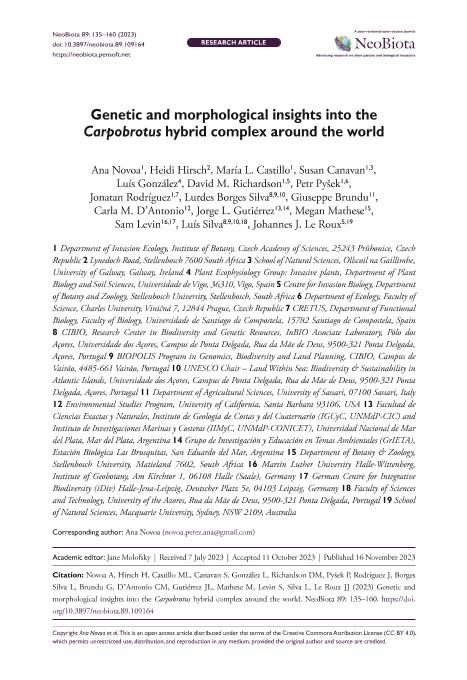Mostrar el registro sencillo del ítem
dc.contributor.author
Novoa, Ana
dc.contributor.author
Hirsch, Heidi
dc.contributor.author
Castillo, María L.
dc.contributor.author
Canavan, Susan
dc.contributor.author
González, Luís
dc.contributor.author
Richardson, David M.
dc.contributor.author
Pyzek, Petr
dc.contributor.author
Rodríguez, Jonatan
dc.contributor.author
Borges Silva, Lurdes
dc.contributor.author
Brundu, Giuseppe
dc.contributor.author
D'Antonio, Carla M.
dc.contributor.author
Gutierrez, Jorge Luis Ceferino

dc.contributor.author
Mathese, Megan
dc.contributor.author
Levin, Sam
dc.contributor.author
Silva, Luís
dc.contributor.author
Le Roux, Johannes

dc.date.available
2024-02-07T11:06:29Z
dc.date.issued
2023-11-16
dc.identifier.citation
Novoa, Ana; Hirsch, Heidi; Castillo, María L.; Canavan, Susan; González, Luís; et al.; Genetic and morphological insights into the Carpobrotus hybrid complex around the world; Pensoft Publishers; NeoBiota; 89; 16-11-2023; 135-160
dc.identifier.issn
1619-0033
dc.identifier.uri
http://hdl.handle.net/11336/226085
dc.description.abstract
The genus Carpobrotus N.E.Br. comprises between 12 and 25 species, most of which are native to South Africa. Some Carpobrotus species are considered among the most damaging invasive species in coastal dune systems worldwide. In their introduced areas, these species represent a serious threat to native species and significantly impact soil conditions and geochemical processes. Despite being well studied, the taxonomy of Carpobrotus remains problematic, as the genus comprises a complex of species that hybridize easily and are difficult to distinguish from each other. To explore the population genetic structure of invasive Carpobrotus species (i.e., C. acinaciformis and C. edulis) across a significant part of their native and non-native ranges, we sampled 40 populations across Argentina, Italy, New Zealand, Portugal, South Africa, Spain, and the USA. We developed taxon-specific microsatellite markers using a Next Generation Sequencing approach to analyze the population genetic structure and incidence of hybridization in native and non-native regions. We identified three genetically distinct clusters, which are present in both the native and non-native regions. Based on a set of selected morphological characteristics, we found no clear features to identify taxa morphologically. Our results suggest that the most probable sources of global introductions of Carpobrotus species are the Western Cape region of South Africa and the coastline of California. We suggest that management actions targeting Carpobrotus invasions globally should focus on preventing additional introductions from the east coast of South Africa, and on searching for prospective biocontrol agents in the Western Cape region of South Africa.
dc.format
application/pdf
dc.language.iso
eng
dc.publisher
Pensoft Publishers
dc.rights
info:eu-repo/semantics/openAccess
dc.rights.uri
https://creativecommons.org/licenses/by-nc-sa/2.5/ar/
dc.subject
BIOLOGICAL INVASIONS
dc.subject
GENETIC DIVERSITY
dc.subject
GENETIC STRUCTURE
dc.subject
HYBRIDIZATION
dc.subject
INTRODUCTION HISTORY
dc.subject
INVASIVE ALIEN PLANT
dc.subject
MICROSATELLITE MARKERS
dc.subject
TAXONOMIC UNCERTAINTY
dc.subject.classification
Ciencias de las Plantas, Botánica

dc.subject.classification
Ciencias Biológicas

dc.subject.classification
CIENCIAS NATURALES Y EXACTAS

dc.subject.classification
Genética y Herencia

dc.subject.classification
Ciencias Biológicas

dc.subject.classification
CIENCIAS NATURALES Y EXACTAS

dc.subject.classification
Ecología

dc.subject.classification
Ciencias Biológicas

dc.subject.classification
CIENCIAS NATURALES Y EXACTAS

dc.title
Genetic and morphological insights into the Carpobrotus hybrid complex around the world
dc.type
info:eu-repo/semantics/article
dc.type
info:ar-repo/semantics/artículo
dc.type
info:eu-repo/semantics/publishedVersion
dc.date.updated
2023-12-22T15:37:49Z
dc.identifier.eissn
1314-2488
dc.journal.volume
89
dc.journal.pagination
135-160
dc.journal.pais
Bulgaria

dc.journal.ciudad
Sofia
dc.description.fil
Fil: Novoa, Ana. Czech Academy Of Sciences. Institute Of Botany.; República Checa
dc.description.fil
Fil: Hirsch, Heidi. Lynedoch Road; Sudáfrica
dc.description.fil
Fil: Castillo, María L.. Czech Academy Of Sciences. Institute Of Botany.; República Checa
dc.description.fil
Fil: Canavan, Susan. University of Galway; Irlanda
dc.description.fil
Fil: González, Luís. Universidad de Vigo; España
dc.description.fil
Fil: Richardson, David M.. Czech Academy of Sciences. Institute of Botany; República Checa
dc.description.fil
Fil: Pyzek, Petr. Czech Academy Of Sciences. Institute Of Botany.; República Checa
dc.description.fil
Fil: Rodríguez, Jonatan. Czech Academy Of Sciences. Institute Of Botany.; República Checa
dc.description.fil
Fil: Borges Silva, Lurdes. Universidade dos Açores; Portugal
dc.description.fil
Fil: Brundu, Giuseppe. University of Sassari; Italia
dc.description.fil
Fil: D'Antonio, Carla M.. University of California; Estados Unidos
dc.description.fil
Fil: Gutierrez, Jorge Luis Ceferino. Consejo Nacional de Investigaciones Científicas y Técnicas. Centro Científico Tecnológico Conicet - Mar del Plata. Instituto de Investigaciones Marinas y Costeras. Universidad Nacional de Mar del Plata. Facultad de Ciencias Exactas y Naturales. Instituto de Investigaciones Marinas y Costeras; Argentina
dc.description.fil
Fil: Mathese, Megan. Stellenbosch University; Sudáfrica
dc.description.fil
Fil: Levin, Sam. Martin Luther University Halle-wittenberg; Alemania. German Centre for Integrative Biodiversity Research; Alemania
dc.description.fil
Fil: Silva, Luís. University of the Azores; Portugal. Universidad de Porto. Facultad de Ciências. Centro de Investigação em Biodiversidade e Recursos Genéticos; Portugal
dc.description.fil
Fil: Le Roux, Johannes. Macquarie University; Australia. Stellenbosch University; Sudáfrica
dc.journal.title
NeoBiota
dc.relation.alternativeid
info:eu-repo/semantics/altIdentifier/url/https://neobiota.pensoft.net/article/109164/
dc.relation.alternativeid
info:eu-repo/semantics/altIdentifier/doi/http://dx.doi.org/10.3897/neobiota.89.109164
Archivos asociados
